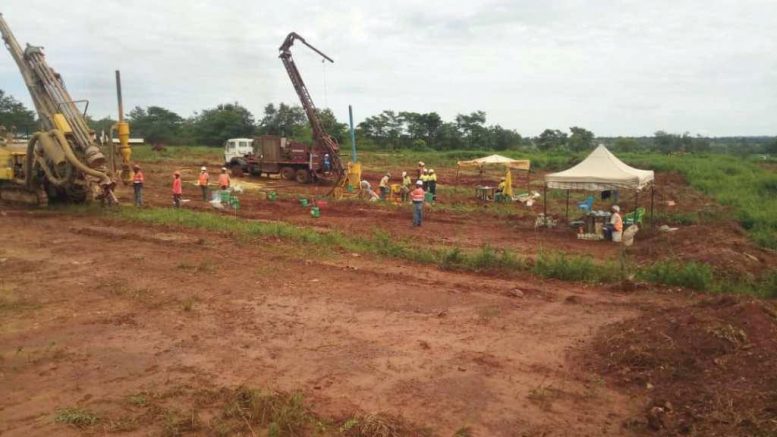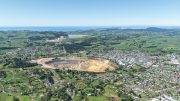Tanzanian Gold (TSX: TNX; NYSE:TRX) has updated the resource estimate for its Buckreef gold project, about 110 km southwest of the city of Mwanza in north-central Tanzania.
The Buckreef shear zone now contains 40.99 million tonnes grading 1.73 grams gold per tonne for 2.27 million oz. contained gold, up from a 2018 estimate of 21.99 million tonnes grading 1.54 grams gold per tonne for 1.09 million ounces. The resource estimate used a 0.5 gram gold per tonne cut-off grade.
“Because of our comprehensive drilling program, we were able to drill into the mineralization and explore right up to the edge of the envelope,” Jim Sinclair, the company’s executive chairman, said in a telephone interview. “So far we have drilled down beyond 950 metres, and we are now looking at a sizeable open pit deposit as well as underground mineralization”
The updated resource estimate incorporated results from Phase I and Phase II drill programs in 2019, which totalled 52 holes over 17,650 metres, representing the most extensive drilling campaign in the company’s history.
Phase I comprised a 15-hole infill drilling program of the open pit with the intention of converting inferred resources to the measured and indicated category.
The Phase II program, the company said, showed robust continuous mineralization below the northern part of the pit.
Hole L25-1, one of the most northerly holes, extended the shear zone over 200 metres along strike and included a 31 metre intercept grading 2.5 grams gold per tonne from 650 metres.
Phase III drilling is now testing the continuity of mineralized structures from surface, through the open pit and below the pit bottom, and below the drilling program conducted in Phase II.

Workers logging core at Tanzanian Gold’s Buckreef gold project in Tanzania. Credit: Tanzanian Gold.
Initial drill results from Phase III included a 38.7 metre intercept grading 5.2 grams gold per tonne starting from 464.3 downhole and 13 metres of 4.6 grams gold per tonne from 360 metres.
“The Phase III drilling program is intended to firm-up not only the numbers but also confirm the quantity as well as the quality of the mineralization. Although the grades are presented as averages, we have seen grades as high as 12, 15 and 19 grams of gold per tonne,” Sinclair said. “The focus of the current metallurgical testing is on final feasibility plant design to treat primary resources in the pit and below the pit bottom.”
In addition, the company has started a grade-control drilling program comprising 79 holes over 1,975 metres for the high-grade oxide resources close to the surface within the open pit. According to a pre-feasibility study, these resources contain less than 1% of the gold and will be treated by a separate, smaller plant.
During the 1980s, the Tanzanian government operated Buckreef as an underground mine.
Since then, previous owners including Iamgold (TSX: IMG) have undertaken exploration programs in the area, including aeromagnetic, helicopter-borne IP, ground magnetic and soil geochemistry surveys, as well as extensive reverse circulation (RC) and diamond drilling programs.
Iamgold verified historic drill data and undertook additional exploration work, including 30,000 soil samples, 202,000 metres of reverse circulation drilling, 124,000 metres of aircore drilling, and 28,000 metres of diamond core drilling.
The Buckreef project covers the eastern portion of the east-west trending Archaean Rwamagaza Greenstone Belt within the Lake Victoria Goldfields of the Tanzanian Craton. Aeromagnetic data indicates the presence of several elongate discontinuous, sheared ultra-mafic bodies that could represent either intrusive bodies or the cumulate portions of thick, magnesium-rich basaltic lava flows.
Gold mineralization at Buckreef is associated with small amounts of fine-grained pyrite within a grey quartz vein. The mineralization runs primarily along an east-west trending brittle-ductile shear zone within deformed mafic volcanic rocks.
Alteration in the zone is characterized by a silica carbonate-pyrite assemblage with well-preserved shear fabric. Gold mineralization is associated with alteration halos and grey quartz zones with the quartz occurring as thin veins, stringers and boudins parallel to the shear fabric.
Tanzanian Gold believes the Buckreef deposit could be similar in terms of geology and size to Barrick Gold’s (TSX: ABX; NYSE: GOLD) Bulyanhulu mine, about 40 km southwest of Buckreef.
Bulyanhulu is a narrow-vein gold mine containing gold, silver and copper mineralization in sulphides and is associated with a number of steeply dipping veins and began production in 2001.
“According to our desktop studies, we could be looking at production levels of 100,000-200,000 ounces per year, so we are expending considerable time, money and effort in confirming the size of the find and planning for the mine’s development,” said Sinclair. “The worse-case scenario is that we have good open pit and underground mineralization, best-case scenario is that we have a mine that is competitive with Bulyanhulu.”
At press time in Toronto Tanzanian Gold was trading at $0.71 within a 52-week trading range of $0.56 to $1.56. The junior has 158 million common shares outstanding for a market cap of 112.5 million.





GREAT NEWS !!! DO YOU EXPECT TO BE PRODUCING GOLD DURING CALENDAR YEAR 2020 – FISCAL OR CALENDAR YEAR YEAR ??
THANK YOU